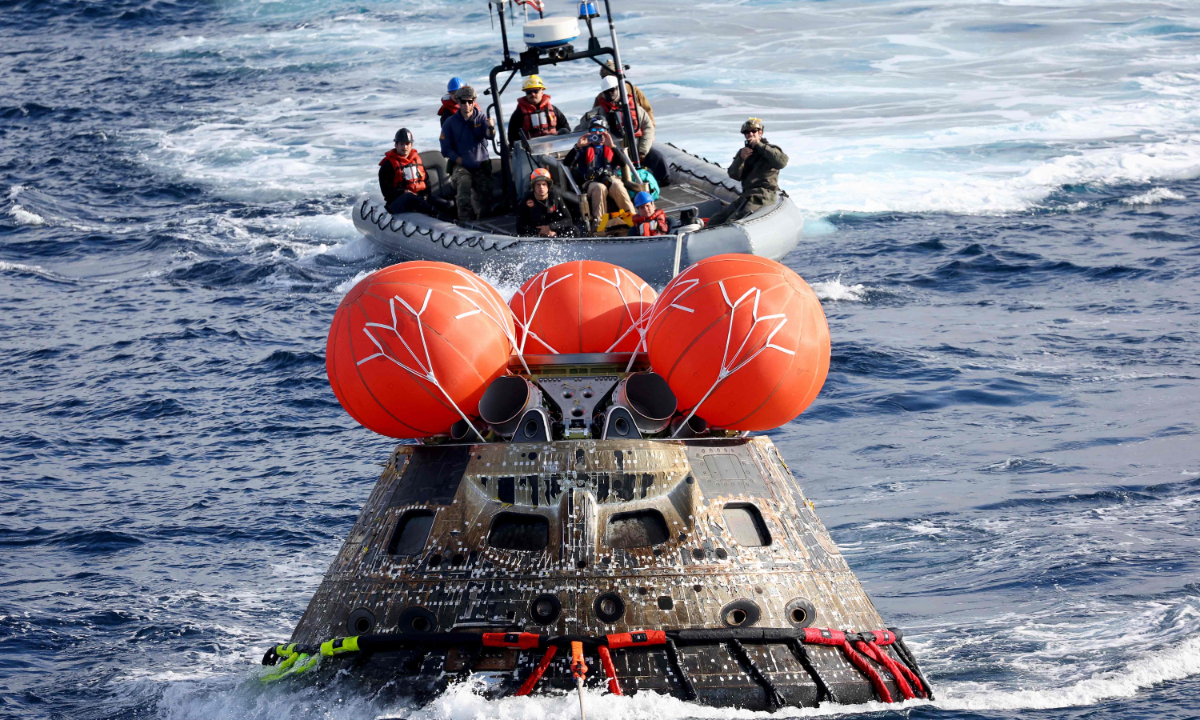
NASA’s Orion Capsule is drawn into the well deck of the USS Portland during recovery operations after it splashed down in the Pacific Ocean off the coast of Baja California, Mexico, on December 11, 2022. Orion was launched November 16 on the Artemis rocket for a 25-day mission to the moon. Photo: VCG
NASA's Orion space capsule splashed down safely in the Pacific on Sunday, completing the 'Artemis 1' mission - a more than 25-day journey around the moon with an eye to returning humans there in just a few years.
After racing through the Earth's atmosphere at a speed of 25,000 miles (40,000 kilometers) per hour, the uncrewed capsule floated down to the sea with the help of three large orange and white parachutes, as seen on NASA TV.
"I don't think any one of us could have imagined the mission this successful," said Artemis Mission Manager Mike Sarafin in a press conference.
"We now have a foundational deep space transportation system."
During the trip around Earth's orbiting satellite and back, Orion logged well over a million miles and went farther from Earth than any previous habitable spacecraft.
"For years, thousands of individuals have poured themselves into this mission, which is inspiring the world to work together to reach untouched cosmic shores," said NASA Administrator Bill Nelson.
"Today is a huge win for NASA, the United States, our international partners, and all of humanity," he added.
After touchdown, helicopters flew over the floating spacecraft, which showed no evidence of damage.
Orion was recovered by a prepositioned US Navy ship off the coast of Mexico's Baja California after some initial tests were run.
As it reentered the Earth's atmosphere, the gumdrop-shaped capsule had to withstand a temperature of 2,800 C - about half that of the surface of the sun.
The main goal of this mission was to test Orion's heat shield - for the day when it carries astronauts.
Achieving success in this mission was key for NASA, which has invested tens of billions of dollars in the Artemis program due to take people back to the moon and prepare for an onward trip, someday, to Mars. A first test of the capsule was in 2014, but that time it stayed in Earth's orbit, coming back into the atmosphere at a slower speed of around 20,000 miles per hour.
The USS Portland was positioned to recover the Orion capsule in an exercise NASA has been rehearsing for years. Helicopters and inflatable boats were also deployed.
The falling spacecraft eased to a speed of 20 miles per hour as it finally hit the Pacific.
NASA let Orion float for several hours - a lot longer than if astronauts were inside - to collect data on temperatures inside the crew module.
Divers then attached cables to hoist Orion onto the USS Portland, an amphibious transport dock vessel whose stern was partly submerged. The water was then pumped out slowly so the spacecraft came to rest on a platform designed to hold it. The Navy ship was then set to head for San Diego, California, where the spacecraft will be unloaded in the coming days.
Orion has now traveled 1.4 million miles since it took off from Florida on November 16, aided by the huge SLS rocket.
At its nearest point to the moon, it flew less than 80 miles from the surface. And it broke the distance record for a habitable capsule from our planet, venturing 268,000 miles away at its farthest point.
URL: https://www.seeglobalnews.com/read-835.html